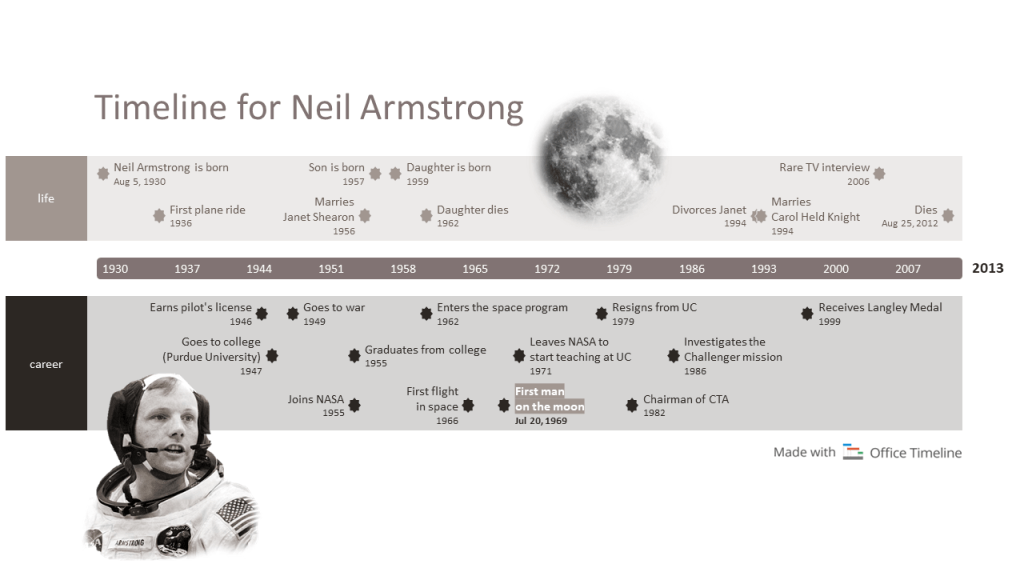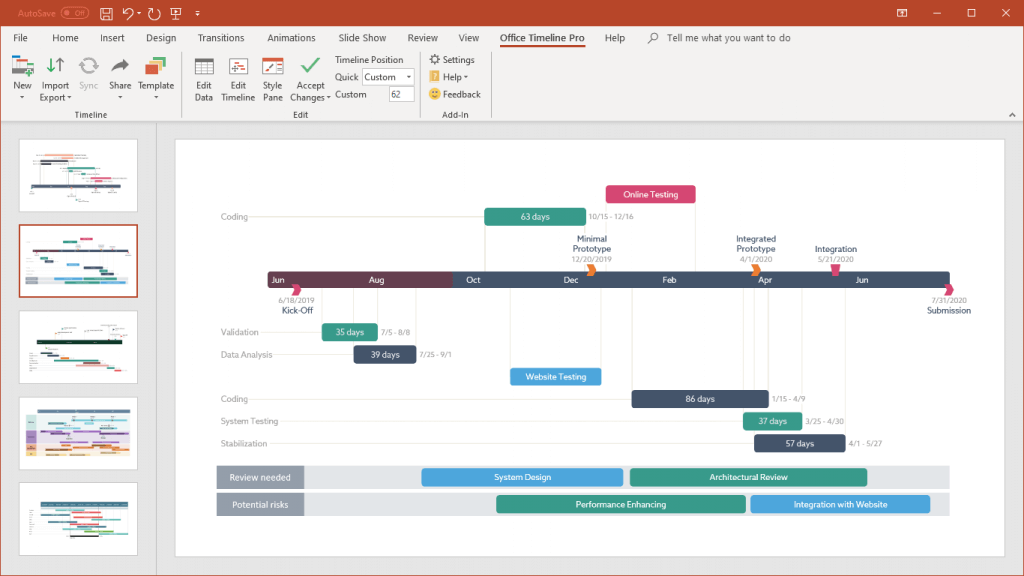Updated on August 2, 2022
Born on August 5, 1930, Neil Armstrong will forever be remembered – maybe despite his wishes – as the first human being to walk on the moon. A humble, private person, the iconic figure was described by his close ones as a “reluctant American hero” who believed he was just doing his job. While he was proud of the role he played in the moon landing, Neil did not want it turned into a circus performance or used for commercial purposes, so he avoided publicity as much as possible.
To commemorate the iconic figure, we have created a timeline for Neil Armstrong, accompanied by a list of frequently asked questions about him and space travel in general. The Neil Armstrong timeline marks major milestones and events in the life and career of the astronaut. Despite being renowned for his voyage to the moon, Armstrong’s original career choice didn’t involve spaceflight. According to his own words, in his youth, all his aspirations were related to flying planes. He took his first plane ride at the age of 6 and earned his flight certificate at 16, even before getting his driver’s license.

The story of an astronaut: a timeline for Neil Armstrong
- 1930, August 5: Neil Armstrong is born
- 1936: First plane ride
- 1947: Goes to college (Purdue University)
- 1949: Goes to war
- 1955: Graduates from college
- 1955: Joins NASA
- 1956: Marries Janet Shearon
- 1957: Neil Armstrong’s son is born
- 1959: Daughter is born
- 1962: His daughter, Karen, dies of DIPG, a rare, fast-growing brain tumor. This tragic event on Neil Armstrong’s timeline will stay with him for the rest of his life. According to the biography written by Jay Barbree, Karen never left her father’s thoughts, and her memory fueled him in space.
- 1962: Neil enters the space program
- 1966: Armstrong’s first flight in space
- 1969: Neil Armstrong becomes the first man to step on the moon
- 1971: Leaves NASA to start teaching at UC
- 1982: Becomes chairman of Computing Technologies for Aviation
- 1986: Investigates the Challenger mission
- 1994: Divorces Janet
- 1994: Marries Carol Held Knight
- 1999: Receives the Langley Medal for outstanding contributions to astronautics and aeronautics
- 2006: Gives rare TV interview
- 2010: Speaks out against cuts to the space program
- 2012, August 25: Dies at age 82 because of complications resulting from heart surgery
Frequently asked questions about Neil Armstrong’s life
If, after reading the Neil Armstrong timeline, you’re curious to learn more details about the “reluctant American hero”, have a look at the commonly asked questions below for more interesting facts:
According to the world, the most important event in Neil Armstrong’s life is certainly the moment he walked on the moon on July 20, 1969. For Neil Armstrong personally, one of the most critical events – and the most devastating – might have been the death of his daughter, which it’s said to have affected him profoundly for the rest of his life. Other important events on Armstrong’s timeline are:
· His first plane flight, when he was just 6 years old;
· The moment he joined NASA, in 1955;
· When his children were born, in 1957 and 1959;
· When he flew to space for the first time, in 1966.
In 1946, Neil Armstrong got his student’s pilot license. He had started to take flying lessons at 15 and got his pilot license right when he turned 16, on August 5,1946, before he even had a driver’s license.
Neil Armstrong became famous for landing on the moon, but what are some interesting facts about him that you might not know?
1. Armstrong went to the North Pole in 1985, in an expedition organized by professional explorer Mike Dunn.
2. He almost died in a practice vehicle meant to replicate the gravity on the Moon. Armstrong quickly ejected and saw the vehicle fall to the ground and explode.
3. Neil Armstrong helped NASA invent an electronic navigation system named fly-by-wire (FBW).
The Neil Armstrong timeline shows that the astronaut joined NASA’s space program in 1962 and made his first flight in space in 1966, as command pilot of Gemini 8. This means it took Armstrong 4 years to fly in space from the moment he entered the space program.
Born in August 1930, Armstrong was 38 years old when he went on the Apollo 11 mission. The pilot was backup commander for Apollo 8 when he was offered to serve as commander for Apollo 11, in December 1968. The Apollo 11 crew was assigned at the beginning of 1969, and the spaceflight launched in July 1969.
Armstrong stepped on the moon on July 21, 1969, at 2:56 am UTC (July 20, 10:56 pm EDT), and spoke the famous words “one small step for [a] man, one giant leap for mankind”. This was six hours and 39 minutes after Buzz Aldrin landed the lunar module on July 20 at 08:17 pm UTC (04:17 pm EDT).
Neil Armstrong and the rest of the Apollo 11 crew stayed a total of 21 hours and 36 minutes on the moon. However, most of that time was spent inside the lunar module. Armstrong and Aldrin spent only 2 hours and 31 minutes outside on the surface, during which they planted the American flag, took pictures, set up experiments, and had the historic phone call with President Richard Nixon.
Apollo 11 was the first manned mission to land on the moon, with commander Neil Armstrong being the first human to ever walk the moon’s surface on July 21, 1969. Before that, there were several unmanned attempts, with the Soviet Luna 1 being the first spacecraft to fly by the moon, and Luna 2 – the first hard moon landing, which means an intentional crash into the moon.
As of 2022, astronaut and naval aviator Eugene (Gene) Cernan was the last person walk on the moon, as commander of Apollo 18 in 1972. Cernan graduated Purdue University, just like Neil Armstrong, making the institution the alma mater of both the first and the last human being to touch the moon’s surface.
Starting from the first manned moon landing which made Neil Armstrong famous, there are 24 people that have been to the moon. Out of them, only 12 actually walked on the lunar surface, all part of the Apollo program. These are:
· Neil Armstrong (Apollo 11)
· Buzz Aldrin (Apollo 11)
· Pete Conrad (Apollo 12)
· Alan Bean (Apollo 12)
· Alan Shepard (Apollo 14)
· Edgar Mitchell (Apollo 14)
· David Scott (Apollo 15)
· James Irwin (Apollo 15)
· John Young (Apollo 16)
· Charles Duke (Apollo 16)
· Eugene Cernan (Apollo 17)
· Harrison Schmitt (Apollo 17)
The Neil Armstrong timeline shows that the famous astronaut became the first man on the moon in July 1969. But how long did it take him and his crew to get there? Apollo 11 launched on July 16 and landed on the moon on July 20. It took the crew 4 days, 6 hours, and 45 mins to get to the moon.
There is a total of 7 flags that were planted on the moon. Six belong to the US, from each of the Apollo expeditions that landed on the lunar surface, and the seventh belongs to China. Another flag that is often overlook but did reach the moon is the Soviet flag, which was carried by Luna 2, the first unmanned mission to hard land on the lunar surface.
So, the total number of flags on the moon would technically be 8 if we take into account the one on Luna, but it’s not known how many of them are still standing. The first flag, belonging to the Apollo 11 mission, is said to have been blown away by the rocket blast when the module left the moon.
About the Neil Armstrong timeline
Our timeline for Neil Armstrong was created using the Office Timeline PowerPoint add-in and can be copied, edited and reproduced for private or public use. To create similar visuals fast, we recommend using the Pro+ edition of the add-in, which comes with powerful customization and productivity features to help you build stunning timelines and roadmaps effortlessly.
Download the Neil Armstrong timeline for PowerPoint and edit it using PowerPoint’s controls, or get your free trial of Office Timeline Pro to update it in seconds and build your own visual chronologies effortlessly.

Turn project data into professional timelines
Get the advanced features of Office Timeline Pro+ free for 14 days.
Get free trial